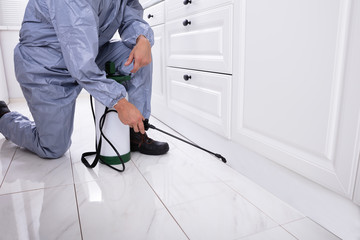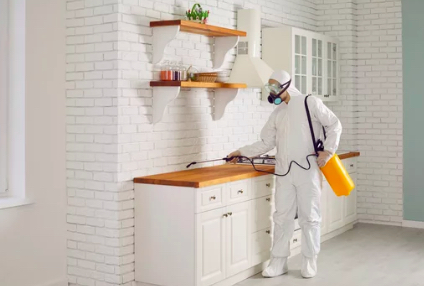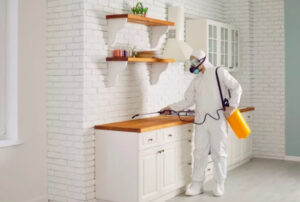Extermination is the last resort in managing pest infestations. Pest Control Knoxville TN experts recommend prevention strategies, including extensive cleaning protocols, establishing sanitary conditions, quickly resolving spills and other problems, and conducting regular inspections to spot early warning signs.
Chelmno and other extermination camps used gas vans that asphyxiated victims with carbon monoxide. Barrier sprays, by contrast, create a boundary that pests can’t cross.
Chemicals
 Chemicals are widely used to control pests because they are easy to apply and work quickly. However, they can also be toxic to the environment and people. As a result, they often cause ecological imbalances. For example, when animal species that are natural predators of pest insects are killed with pesticides, the pests suddenly have no natural enemy and multiply rapidly. They can also become resistant to the chemicals. Moreover, many chemical pesticides are persistent organic pollutants (POP) that accumulate in the fat of marine mammals and disrupt the endocrine system. They are also found in groundwater, in soil and waterways, and in the food of humans and animals.
Chemicals are widely used to control pests because they are easy to apply and work quickly. However, they can also be toxic to the environment and people. As a result, they often cause ecological imbalances. For example, when animal species that are natural predators of pest insects are killed with pesticides, the pests suddenly have no natural enemy and multiply rapidly. They can also become resistant to the chemicals. Moreover, many chemical pesticides are persistent organic pollutants (POP) that accumulate in the fat of marine mammals and disrupt the endocrine system. They are also found in groundwater, in soil and waterways, and in the food of humans and animals.
Gases
Gases are a common method of pest control, but they have some disadvantages. They are less effective than solids and liquids at killing pests, but they can still be used to destroy them by exposing them to toxic chemicals. They can also cause harmful effects to the environment, especially when they are released into the air.
One example of a dangerous chemical gas is carbon monoxide, commonly known as CO. This poisonous gas can enter homes and businesses through poorly ventilated chimneys and furnaces. This gas is extremely dangerous to humans, and can lead to death from asphyxiation. It can also be deadly to pets and plants.
When CO enters a room, it is odorless and tasteless. It can also be absorbed through the skin, causing a severe burning sensation. A person who is exposed to a large enough concentration of CO can die from asphyxiation within minutes. It is important to have a CO detector in your home, and to keep it well-maintained so that you can detect any CO levels in the air.
In the 1940s, the Nazis began experimenting with poison gas for mass murder. Their first attempt was to use carbon monoxide in their Euthanasia Program, a German euphemism for the systematic killing of people with mental and physical disabilities. Six gassing installations were set up in Germany, and used pure carbon monoxide to kill patients.
After the success of the Euthanasia Program, the Nazis searched for a more efficient means of extermination. They found Zyklon B, a pelletized form of hydrocyanic acid, and started using it in the camps in 1941. It was a more convenient and efficient method of killing than shooting.
A typical fumigation process begins by tightly sealing the structure or container in question. This can be done through tenting or taping, and may involve putting up signs warning others that the area is closed off. Once the fumigation is complete, the professional will remove the tent and allow the house to aerate for a day or two before it is safe to return.
The most common fumigant for termite fumigation is Vikane. This is a colorless, odorless gas that is effective at killing termites and other bugs. It is also effective against cockroaches, scorpions, and other insects. It is one of the longest running pest control products, and has been around for more than 50 years. It is also believed to have minimal impact on the ozone layer, although recent research has shown that it may have a small negative impact.
Biological methods
Biological pest control uses natural enemies such as predators, parasites or disease organisms to reduce or prevent the proliferation of a target pest. These natural enemies may be introduced at a time when the pest is exhibiting symptoms, or they can be used to suppress an established problem. The latter approach is called augmentation, and it typically involves the use of commercially available species of natural enemy that are introduced at a critical point in the pest’s life cycle or to supplement naturally occurring populations present in the environment. Examples of biological control include the eradication of citrophilus mealybug by parasitic wasps, the effective predation on the cottony cushion scale by an Australian insect, Coccophagus gurneyi or the use of Bacillus thuringiensis to reduce aphid problems in home gardens.
The most commonly used natural enemies are a variety of predators, including spiders, lacewings, ground beetles and ladybugs, as well as rove beetles, flower flies and hover flies, parasitic wasps and flies (more than 8,500 species), nematodes, plant pathogenic bacteria and fungi. Biological control is also possible through the use of genetically engineered, sterilized natural enemies that are specific to a particular pest and cannot be propagated in other environments. Such organisms are often used in conjunction with other non-chemical methods, such as the use of select pesticides that do not kill the targeted pest or its natural enemies, and good cultural practices that support the establishment of beneficial insects, such as maintaining ground covers, providing insect habitat and food sources and avoiding crop residues.
Most biological control agents, including parasitoids and nematodes, are generally pest-specific and must be released at the exact time when the pest population is at its highest. Unless conditions are highly controlled, such as in greenhouses or interiorscapes, the results of outdoor releases can be unpredictable and often are not consistent. Companies selling biological control products and claiming success should give directions as to how to use the product, and should assure that the specific natural enemy being offered is provided in each shipment. Ionizing radiation can also be used to sterilize biological control agents, making them safe for transport and release in new environments without fear that they will become natural enemies of other crops or plants.
Other methods
There are a few other methods of pest control that can be used. These include physical extermination, biocontrol extermination and sterilisation programmes. Physical extermination involves using barriers to prevent pests from entering a home. This may involve removing access points such as doors and windows, sealing cracks and crevices, and removing rubbish from the area. It can also include traps and baits to catch and kill pests.
These are a great way to control pests, but can be very expensive. They can also be dangerous if used incorrectly, so should only be considered if advised by a professional. Biocontrol extermination uses natural enemies to control pest populations. This is a very complex process and requires extensive research into the biology of the pest, possible natural enemies and their own biology, and balancing the release of natural enemies against unintended consequences such as affecting native species that do not feed on the target pest or other ecological processes.
A common example is the cockroach, which will invade a kitchen if there are leftover food scraps, a leaking faucet and other conditions such as warm temperatures and moisture. Cockroaches are known to carry bacteria and germs that cause diseases such as cholera, typhoid and dysentery. They can also spread a number of viruses including polio, West Nile virus, dengue, chikungunya and malaria.
The term exterminate is derived from the Latin exterminatus, meaning to drive out or away. However, the current meaning of the word has more to do with destroying or annihilating something. This is the meaning that pest control professionals have in mind when they exterminate pests from homes and businesses.
Pest infestations can be a nightmare for homeowners, and can result in expensive repair bills and property devaluation. Pests can also be a health risk, spreading bacteria and germs that can lead to disease. In addition, they can damage property and even contaminate food and drink products. Regular pest maintenance by a pest control service provider can prevent these problems, and save money, time and health issues in the long run. It is worth noting that if pests are left unchecked, they can breed rapidly, leading to a bigger problem and more expense.

